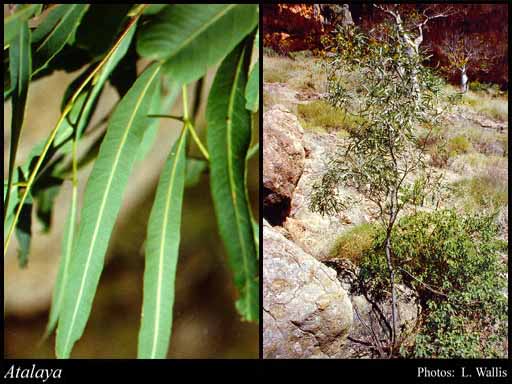- Reference
- Rumphia 186 (1847)
- Name Status
- Current







Scientific Description
Common name. Whitewood. Family Sapindaceae.
Habit and leaf form. Trees, or shrubs; laticiferous, or non-laticiferous and without coloured juice. Stem internodes solid. Mesophytic. Leaves alternate; spiral; petiolate (petiole and rachis usually winged); non-sheathing; gland-dotted, or not gland-dotted; simple (rarely), or compound; pulvinate (often?), or epulvinate; when compound, pinnate; paripinnate, or imparipinnate. Leaflets long and narrow. Leaf blades when simple, dissected (sometimes deeply lobed), or entire; when simple/dissected, pinnatifid; pinnately veined (with fine laterals); cross-venulate. Leaves without stipules. Leaf blade margins entire. Leaf anatomy. Hairs present. Extra-floral nectaries absent. Stem anatomy. Secondary thickening developing from a conventional cambial ring, or anomalous.
Reproductive type, pollination. Fertile flowers hermaphrodite, or functionally male, or functionally female, or hermaphrodite, functionally male, and functionally female. Unisexual flowers present (usually), or absent. Plants hermaphrodite (KLB), or dioecious (usually), or polygamomonoecious (KLB). Female flowers with staminodes. Male flowers with pistillodes.
Inflorescence and flower features. Flowers aggregated in ‘inflorescences’; in panicles. The terminal inflorescence unit cymose. Inflorescences terminal, or axillary (upper); cymules shortly stalked. Flowers pedicellate; bracteate; bracteolate, or ebracteolate; small; somewhat irregular, or very irregular; 4 merous, or 5 merous; cyclic; tetracyclic, or tricyclic. Free hypanthium absent. Hypogynous disk present; extrastaminal; annular. Perianth with distinct calyx and corolla; 8–10; 2 -whorled; isomerous. Calyx present; 5 (unequal); 1 -whorled; polysepalous, or gamosepalous (usually); imbricate, or valvate; unequal but not bilabiate; with the median member posterior. Sepals free lobes elliptic to ovate, or orbicular (subcircular). Corolla present; 4–5 (usually); 1 -whorled; appendiculate, or not appendiculate; gamopetalous; imbricate; unequal but not bilabiate, or regular. Petals elliptic to ovate. Fertile stamens present, or absent (female flowers). Androecial members definite in number. Androecium 8. Androecial members free of the perianth; free of one another; 2 -whorled (rather theoretically 5+5), or 1 -whorled. Androecium of male-fertile flowers exclusively of fertile stamens. Stamens 8; all more or less similar in shape; diplostemonous to polystemonous; all around the ovary inside the disc; filantherous. Anthers dorsifixed, or basifixed; more or less versatile; dehiscing via longitudinal slits; introrse; tetrasporangiate; appendaged, or unappendaged. The anther appendages apical (by connective extension). Fertile gynoecium present, or absent (male flowers). Gynoecium 3 carpelled. The pistil 3 celled. Carpels reduced in number relative to the perianth, or isomerous with the perianth. Gynoecium syncarpous; synovarious to eu-syncarpous; superior. Ovary plurilocular; 3 locular. Gynoecium stylate. Styles 1; free, or partially joined; attenuate from the ovary, or from a depression at the top of the ovary; apical. Stigmas 1. Placentation axile to basal. Ovules 1 per locule; funicled, or sessile; pendulous, or horizontal, or ascending; non-arillate; hemianatropous, or anatropous, or campylotropous, or amphitropous.
Fruit and seed features. Fruit non-fleshy; a schizocarp. Mericarps samaroid. Seeds non-endospermic. Cotyledons 2. Embryo curved, or bent, or coiled.
Etymology. The vernacular name in Timor for one of the species.
Taxonomic Literature
- Reynolds, Sally T. 1981. Notes on Sapindaceae in Australia. I.